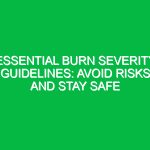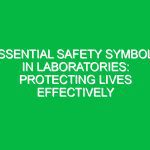I. Introduction: Why Identifying Carcinogens in the Workplace is Crucial for Health and Safety
In our daily work environments, the presence of carcinogens can pose serious health risks that may not be immediately apparent. Understanding and identifying these hazardous substances is vital for ensuring the Safety and well-being of all employees. Carcinogens are substances that can lead to cancer after prolonged exposure, making awareness and proactive measures essential.
A. Definition of Carcinogens
A carcinogen is any substance that can cause cancer in living tissue. This includes various chemicals, physical agents like radiation, and biological factors such as certain viruses. For instance, asbestos, once widely used in construction, is a known carcinogen that can lead to lung cancer and mesothelioma when inhaled. Are you aware of any carcinogens present in your workplace?
B. Importance of Awareness and Identification
Awareness and identification of carcinogens are crucial for preventing exposure and reducing health risks. When employees understand what carcinogens are and where they can be found, they can take necessary Precautions. For example, a worker in a chemical plant must recognize the potential risks associated with handling specific substances and take steps to protect themselves. As an employee, how often do you review safety data sheets (SDS) for the materials you work with?
C. Overview of Workplace Risks
Workplaces vary widely in their exposure to carcinogens, depending on the industry and specific job functions. Manufacturing facilities may expose workers to chemical fumes, while construction sites might involve materials like asbestos and silica dust. Understanding these risks is the first step toward effective Prevention. Can you think of any tasks in your job that might expose you to hazardous materials?
II. Understanding Carcinogens: Types and Sources in the Workplace
Carcinogens can be classified based on the level of evidence supporting their cancer-causing potential. Knowing the types and sources of carcinogens in your workplace helps you to identify potential risks effectively.
A. Classification of Carcinogens
Carcinogens are typically classified into three groups based on their potential to cause cancer:
- Group 1: Human Carcinogens – These substances have sufficient evidence to show they cause cancer in humans. An example is tobacco smoke.
- Group 2A: Probably Carcinogenic – These have limited evidence linking them to cancer in humans but sufficient evidence in animals, such as glyphosate.
- Group 2B: Possibly Carcinogenic – These are substances with limited evidence of human carcinogenicity, such as certain artificial sweeteners.
B. Common Sources of Carcinogens
Carcinogens can originate from various sources within the workplace. Here are a few common types:
- Chemical Exposure: Substances like benzene, used in chemical manufacturing, are known carcinogens. Workers handling these chemicals should be aware of their risks.
- Physical Agents: Exposure to radiation, such as from X-ray machines in medical settings, can increase cancer risk if safety protocols are not followed.
- Biological Agents: Certain viruses, like human papillomavirus (HPV), are linked to cancer and can pose a risk in healthcare settings. Have you ever considered how biological agents might affect your work Environment?
III. Hazard Identification: How to Recognize Carcinogens in Your Work Environment
Recognizing the presence of carcinogens is a key component of Workplace Safety. Identifying Hazards early can prevent potential exposure and health issues.
A. Recognizing Warning Signs
Several indicators can help you identify carcinogens:
- Labels and Safety Data Sheets (SDS): Always check labels on chemical containers and refer to the SDS for information about hazardous materials. For instance, if you work with solvents, the SDS will provide vital information regarding their carcinogenic properties.
- Worker Exposure Reports: Keep an eye on reports that highlight exposure levels within your workplace. Understanding these reports can help you gauge your potential risk. Have you reviewed your workplace’s latest exposure report?
B. Common Work Areas with Carcinogenic Risks
Some areas in the workplace are more prone to carcinogenic exposure:
- Manufacturing Facilities: These often involve chemicals that can be carcinogenic, such as formaldehyde in certain adhesives.
- Construction Sites: Here, exposure to asbestos and silica dust can be prevalent, particularly during demolition or renovation.
- Laboratories: Research settings may involve handling chemicals and biological agents that pose cancer risks. Are there Safety Measures in place in your lab to minimize these risks?
IV. Risk Assessment: Evaluating Carcinogenic Risk Levels
Conducting a thorough risk assessment is essential for understanding who might be at risk of exposure to carcinogens in the workplace.
A. Identifying Who is at Risk
Assessing risk begins with identifying who may be exposed to carcinogens. This includes workers directly handling hazardous materials, as well as those in the vicinity. For example, in a manufacturing plant, operators and Maintenance staff may face varying levels of exposure. Have you considered your own risk level in relation to your job tasks?
B. Evaluating Potential Impact
After identifying at-risk individuals, evaluate the potential impact of exposure:
- High-Risk Activities: Tasks that involve heavy handling of carcinogenic substances, such as mixing chemicals, are typically high-risk.
- Medium and Low-Risk Assessments: Office workers might be at low risk, but they should still be aware of potential Hazards, such as printer toner. How do you assess your daily exposure risk?
C. Documenting Risk Findings
Documenting your findings is crucial for tracking exposure and implementing preventive measures. Create records of identified risks and share them with your team. This transparency encourages a culture of safety. Have you documented any potential risks in your workspace recently?
V. Preventive Measures: Step-by-Step Strategies to Minimize Exposure
Implementing preventive measures can significantly reduce the risk of carcinogen exposure. Here are some effective strategies:
A. Engineering Controls
Engineering controls involve modifying the work environment to minimize exposure:
- Ventilation Systems: Proper ventilation helps dilute airborne carcinogens, making the environment safer. For instance, local exhaust ventilation can be essential in welding operations.
- Enclosures and Barriers: Physical barriers can prevent direct exposure to hazardous substances, such as isolating chemical processes from workers. Are there adequate barriers in your work area?
B. Administrative Controls
Administrative controls can also play a vital role in reducing exposure:
- Work Scheduling: Rotating job assignments can limit the time workers spend in high-exposure areas, reducing overall risk.
- Employee Training Programs: Continuous training on recognizing and mitigating hazards is essential. Have you participated in any recent training regarding carcinogen awareness?
C. Personal Protective Equipment (PPE)
PPE is your last line of defense against carcinogens:
- Types of PPE for Carcinogen Exposure: Depending on the exposure risk, gloves, respirators, and protective clothing may be necessary. For instance, lab coats and gloves are crucial when handling hazardous chemicals.
- Proper Use and Maintenance: It’s not just about having PPE; using it correctly and maintaining it is essential. Regularly inspect your equipment to ensure it meets safety Standards. How often do you check your PPE before starting work?
VI. Control Measures: Actions to Take if Exposure Occurs
In the unfortunate event of exposure, knowing the appropriate Control Measures to take can mitigate risks.
A. Immediate Response Procedures
If you suspect exposure, immediate response is key. For instance, if you inhale a carcinogenic substance, move to fresh air and seek medical attention if symptoms develop. Are you familiar with the emergency protocols for your workplace?
B. Monitoring and Surveillance Programs
Regular monitoring can help identify and manage exposure levels. Implementing health surveillance for employees can also catch potential health issues early. How often does your workplace conduct health assessments related to carcinogen exposure?
C. Reporting and Investigation of Incidents
Reporting incidents of exposure is crucial for Workplace Safety. Each report should be investigated thoroughly to prevent future occurrences. Have you reported any safety concerns in your workplace recently?
VII. Safe Work Procedures: Establishing Guidelines for Safe Practices
Establishing clear safe work procedures is essential for maintaining a safe work environment.
A. Developing Standard Operating Procedures (SOPs)
SOPs should be developed for handling carcinogenic substances. These procedures should detail safe handling, storage, and disposal methods. Do you have access to the SOPs relevant to your job tasks?
B. Training Employees on Safe Work Practices
Regular training sessions ensure that employees understand the SOPs and the importance of adhering to them. Training can include hands-on demonstrations and discussions about potential hazards. Have you participated in any safety training sessions this year?
C. Ensuring Compliance with Procedures
Compliance with established procedures is crucial. Regular audits can help ensure that safety practices are being followed. It’s everyone’s responsibility to uphold safety standards. How does your team ensure compliance with safety procedures?
VIII. Emergency Procedures: Incident Response and Reporting
Having comprehensive emergency procedures in place can save lives in case of exposure incidents.
A. Emergency Response Plans for Carcinogen Exposure
Your workplace should have clear emergency response plans detailing steps to take in case of carcinogen exposure. These plans should be accessible to all employees. Are you familiar with your workplace’s emergency plans?
B. Reporting Procedures for Suspected Exposures
Establish clear reporting procedures for suspected exposure. Timely reporting can help address risks before they escalate. Have you been trained on the reporting procedures in your workplace?
C. Follow-Up Health Monitoring for Affected Workers
After exposure incidents, affected workers should undergo follow-up health monitoring to identify any long-term Effects. Regular check-ups can help catch potential health issues early. Have you had a health assessment after a potential exposure?
IX. Employee Responsibilities: What Workers Must Do to Ensure Safety
Every employee plays a role in maintaining a safe work environment and must be proactive about their safety and that of their colleagues.
A. Awareness of Carcinogenic Risks
Employees must remain vigilant about the risks associated with carcinogens in their workplace. Keeping updated on safety data and participating in training can enhance awareness. What steps do you take to stay informed about potential hazards in your work environment?
B. Reporting Unsafe Conditions
Reporting unsafe conditions is vital for Workplace Safety. If you notice a potential hazard, report it immediately. This proactive approach can prevent exposure and promote a culture of safety. Have you ever reported an unsafe condition?
C. Participation in Training and Safety Programs
Engagement in training and safety programs is essential for personal and collective safety. Your participation not only Benefits you but also your coworkers. How often do you take part in safety training initiatives?
X. Regulations & Standards: Relevant HSE Regulations and Compliance
Understanding the regulations and standards governing carcinogens in the workplace is crucial for compliance and safety.
A. Overview of OSHA Standards on Carcinogens
The Occupational Safety and Health Administration (osha) outlines standards regarding exposure limits to carcinogens. Familiarizing yourself with these standards will help ensure compliance in your workplace. Do you know the OSHA standards applicable to your job?
B. Other Relevant Regulations (e.g., EPA, ISO)
In addition to OSHA, other regulations such as those from the Environmental Protection Agency (EPA) and International Organization for Standardization (ISO) also play a role in Workplace Safety. Understanding these can help you comply with Best Practices. How does your workplace incorporate these regulations into daily operations?
C. Application of Regulations in the Workplace
Applying these regulations in your workplace requires diligence from everyone. Regular training and audits can help ensure compliance. Have you seen evidence of regulatory application in your workplace?
XI. Q&A / Discussion: Engaging Workers with Questions
Encouraging open discussion about carcinogens and Workplace Safety can foster a proactive safety culture. Consider holding a Q&A session where employees can voice their concerns and share experiences. What questions do you have regarding carcinogens in your work environment?
In conclusion, understanding and identifying carcinogens in the workplace is a shared responsibility that requires active participation from every employee. By following Best Practices, staying informed, and engaging in open discussions, we can create a safer work environment for everyone.


